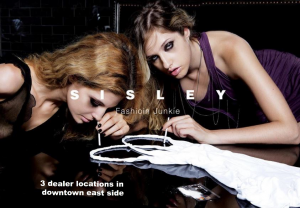
ORIGINAL
This advertisement published by Natan Diamonds has many underlying issues. The left image shows a woman sitting with her legs crossed while a man holds out a jewellery box to her. The picture on the right shows him opening the box to reveal a diamond ring, and the woman has responded with her legs open. Not only is this not a good marketing strategy, as it does not even clearly show the product they are trying to sell, it objectifies both men and women.
The ad is misogynistic because it implies that one can buy a woman’s sex and body. There are some women who want to become intimate when they are in a more serious relationship, or feel comfortable committing to someone. They might think of sex as something as a step after they are devoted to one another. That is a personal choice some women make for themselves. However, it does not mean that a diamond ring is the differentiating factor between celibacy and sex. It suggests that her sexuality is controlled by materials, and she has no will of her own.
Conversely, it also objectifies men in the underlying context. The advertisement depicts a narrative of a couple who are serious – serious enough for a proposal. So, in this case, the man cannot get any intimacy unless he spends money to show his devotion, and only then will his partner have sex with him. He himself is not enough to base relationship decisions on, but its materials he can buy and provide. Since the diamond ring is shown as the only causal factor in sex, I don’t believe this ad is only sexist to women.

CULTURE JAMMED
After advertising Natan Diamonds’ ad, I added the caption “Whoever said bribery doesn’t work, hasn’t seen our diamonds”. This highlights the adverse social message the image was sending to both women and men. It emphasizes that sexism to both sexes can make them feel like commodities, in which sex and money can be traded to influence decisions and feelings. The man is bribing the woman for her sex. She on the other hand is only interested in being intimate with her partner only after an expensive ring is gifted to her. Overall, this ad alteration tries to invoke the message original message even more – that women are mindless about their bodies unless bribed with materials, and the value of men and their relationships are based on what they can buy. It is far from the fact that there are people who love their partners, and symbolize their appreciation and devotion through gifts. Or the fact that there are women who choose to have intercourse later in the relationship when they feel it being more stable and serious. This just reaffirms the longstanding gender roles that women and men have been subjected to – men as material providers and women as submissive sexualized objects. From a marketing and advertising standpoint, not only does this ad not show the product big and clear enough for the consumer, but it also demeans what some people think of marriage and relationships. It is sexist, demeaning and makes the viewer be more uncomfortable associating themselves with the brand, than be interested in what they have to sell.

